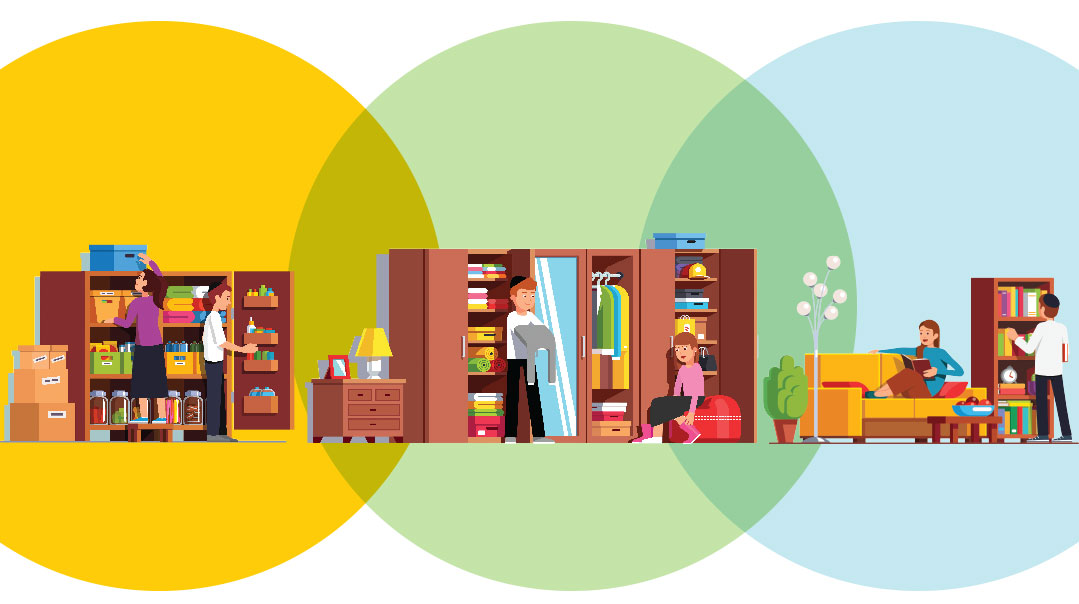How (Not) to Organize Other People

You want to keep your home clean and organized, but other people’s stuff keep getting in the way. How to get your family on board without nagging once

Sarah was on a mission to declutter her home and was praying her family would hop on board. I told her to leave her husband out of the picture; in the meantime, there was plenty of her own junk to deal with without starting on his.
And then it happened.
Sarah came home from shopping one Sunday, and Chaim, her husband, was stuffing shirt after shirt into a big garbage bag. “I don’t wear these anymore,” he said. “Some are small, some are yellowed, and most of these are from ages ago… I thought I would clear up some space in the closet.”
Sarah smiled. Her stuff-loving husband was catching on.
“I see this organizing thing really works! Our home runs so much better now since you got into this,” Chaim said with a grin. “I thought I’d give it a try too.”
I organized a retired couples’ basement. It was overwhelming. Emotional. Scary. We threw out 50 years of just-in-case clothing, canned foods (some had expired nearly 15 years before!), toys, memories, great-grandma’s linens, and the portraits that used to hang on Bubby’s wall.
We finally unearthed the back of the basement, territory no one had walked on in years (decades?) “Can we toss these rotting boxes?” I ever-so-gently asked.
“No,” said 75-year-old Mr. Friedman. “I’m pretty sure those are important papers from my business… I have to go through them. I didn’t even know they were back there.”
We threw out a lifetime of junk, donated what was worthy, and organized the remains neatly on shelves. The basement looked great. Except for those rotting boxes.
“I’ll go get the shredder,” said Mr. Friedman suddenly.
Mrs. Friedman almost fainted. “I’ve been asking you to do that for over 35 years! Why now?”
“I don’t know, all of a sudden, it doesn’t seem like such a big deal!”
Our family members may be messy. And that may be a significant source of frustration in our life.
But there are correct and incorrect methods to get our family involved in creating a more organized home. Let’s explore the principles behind the right and wrong ways to get other people to be better organized and fulfill our dream of finally getting our homes (including their stuff!) into better shape.
1. Pre-sort it
Don’t nag, help! It’s hard to get organized when you’re living in a state of overwhelm. Years of accumulated collections of tools, papers, books, hand-me-downs, just-in-cases and you-never-knows can paralyze a person.
But if it’s not your stuff, then it’s not as paralyzing. If your husband is comfortable with it, do him a favor and pre-sort his tools into organized piles of wires, screws, tools, and valuable finds. Pre-sort his papers into separate piles of work-related, bill-related, medical-related papers, and what you think is garbage.
Then ask him to give you five to ten minutes of his time each day to quickly go through one or two of the piles. Throw out the garbage and offer him a few options to organize the rest. Assure him you’ll do it for him, you’re just asking for his input.
Do the same for your daughter’s papers or your son’s drawer of treasures. In a good relationship, a family member will appreciate this pre-sort, and be grateful to have your help organizing their mess. As we saw, once Mr. Friedman’s basement became less overwhelming, he found the time and energy to deal with his papers.
2. If it’s part of their life, it needs space
Believe it or not, 15-year-old Shira’s mess may actually be our fault. If a teenager is “into” something, we have to allocate a place for it in our home; otherwise it will be, well, everywhere.
If she took up scrapbooking, loves to accessorize every outfit, or collects shoes and handbags — that’s a signal for us to create a home that works for those items. Of course we may not understand why she requires fifty necklaces and ten handbags. We can’t appreciate the need to wear a different pair of shoes for every outfit. But if that’s the stage she’s in — we have to create homes for her stuff.
Teach your preschoolers which of their artwork is worthwhile saving and get them a nice folder to save it in. Same goes for a child who has taken up a hobby — the sewing machine and all the accompanying fabrics need a place to live; the instrument, the music books, stand, and case need to belong in accessible homes.
It’s our job to create those homes. If the space works, there’s a greater likelihood our family members will hop on board and cooperate.
3. Miriam was forever trying to get her husband Dovid to keep track of the many tasks on his mental “to-do” list. He meant well, but wasn’t keeping up with his many responsibilities.
Miriam: “Can you pick up some light bulbs on the way home today?”
Dovid: “Sure.”
Miriam: “Don’t forget to call Yanky’s rebbi.”
Dovid: “Okay.”
Miriam: “The bank called again, they’re waiting for you to get back to them….”
Dovid: “I’ll call them, don’t worry.”
She bought him a daily planner, a memo pad, and pen that fit perfectly in his pocket, as well as a wall calendar — all which remained empty. Miriam’s frustration continued to grow.
“If you want it to happen you have to e-mail me,” explained Dovid.
“Huh? Why should I send you an e-mail? You’re right here! I’m telling you now. Write it down, like I do, and you’ll remember.”
“I check my e-mail before I leave work at the end of the day. If I see it there, I’ll remember to do it on my way home.”
Everyone works differently. Ask your husband how he prefers you to present him with your “list.” Some husbands like written lists and some like calendars; some prefer technology and some like alarms. If you really want a family member to take care of something, let him do it on his terms, not yours.
The same principle goes for the office. Get input from your staff. How do they best receive directives? Some like a written list, given to them first thing in the morning. For others, a written list makes them feel pressured, and they prefer verbal instruction. Some workers need a quiet office to be productive and some thrive in a busy group setting. Some workers express themselves well at staff meetings and some prefer to share their opinions privately. Accommodate your coworkers’ and employees’ personalities to create a more productive office.
4. Help others uncover their personal preferences
Rochel’s teenage daughter Sari had a busy schedule. Although well-meaning and sweet, she was always in a rush and couldn’t be relied upon to help around the home.
Rochel: “Sari, can you wash the dinner dishes?”
Sari: “Sorry, Mom, I’m going to Rivky’s house to study for a big test.”
Rochel: “Sari, can you clear the dining room table please? I need to fold laundry here.”
Sari: “Sorry, Mom, my class is having a get-together now, I’ll do it later.”
After many unsuccessful nagging attempts, Rochel changed gears. She discussed with Sari why she hasn’t been so helpful around the house. Together they realized that Sari detested time-sensitive tasks. They decided that Sari’s job should be to fold the laundry and iron — chores that needed to be done weekly, but could be fit in at whichever time Sari desired.
Not every child, husband, or employee is fully aware of how he works best. Guide them through the process in a positive atmosphere, over coffee and cake, asking questions such as, “Where would you like me to put incoming papers so that you’ll put them away? How large a work space do you need for your homework? Would it help to have the music on or off?
The more a person understands the way he works, the more organized he can be.
5.Organize by design
Shimmy the bookworm had a tower of books piled at the end of his bed. They were beginning to slide onto the floor.
Mom: “Shimmy, please bring some of those books back downstairs to the bookshelf. This is getting out of control!”
Shimmy: “I’m too comfortable to go downstairs now, reading makes me so (yawn) tired….”
Mom also wouldn’t take a trip downstairs when she’s tired to put her magazines in the rack next to the couch where they belong. If she wants Shimmy’s books off the floor, she should design a bookcase for books somewhere near his bed.
If Mom wants little Shaindy to put her dolls away, she should be able to reach her doll shelf easily.
Is your clean laundry dumped all over the place because Dovid is searching for his favorite pair of pants? That doesn’t mean Dovid is messy — it means that your laundry room needs a better design. Quickly sort the clean clothes into labeled baskets according to person, room, or gender, and then Dovid will find his pants easily without having to dump out the rest.
Avreimi’s Playmobil masterpiece, which took hours to create, needs a home, or it will be broken and scattered all over the floor (and left there) by Moishy the two-year-old menace. Mom needs to have display shelves installed in the playroom for the many masterpieces Avreimi creates.
6. Teach the value of things
You can’t force organization upon your children. There’s no button to press to get someone to clean up (trust me, I’ve looked for it) but you can teach your children the value of an object and explain why it’s worthwhile to put it away, says Rebbetzin Devorah Eisenbach, a noted educator in Yerushalayim.
We can tell our children, “We enjoy our toys. They entertain us and teach us, and we want them to last. If we leave them scattered all over the floor, we won’t be able to play with them tomorrow,” or, “We’re grateful to have nice clothes to wear and we need to wear them again soon, so it’s worthwhile to put it in the hamper or hang it back up on the hanger.” Through teaching children to be respect their belongings, the outcome is that (eventually) they will put them away.
Rebbetzin Eisenbach recommends having a few positive mantras on the tip of your tongue on a regular basis. “It’s so nice to live in a home where everyone helps,” or, “It’s so helpful to have a clean cook in the kitchen.” Cheerful sayings like these sink into your children’s minds and stay with them.
7. Focus on the goal
Rebbetzin Eisenbach puts organizing in the proper perspective: “Teach them to enjoy the end result and then they’ll be willing to put in the work.” Instead of focusing on getting family members to clean up for Shabbos, focus on the importance and beauty of Shabbos and how nice it’ll be to be ready on time. Instead of preaching proper time-management skills to a latecomer, help them appreciate what they’re supposed to be doing that day.
All individuals have their own ways of doing things — focus on the goal, not the action, and they’ll find a way to get there.
8. Educate
Shoshana always put her little ones to bed early so she would have time to clean up before her husband came home. Years later, she complained to me that her house is always a mess because her kids don’t clean up. We realized they’d never seen how cleanup was done.
Organizational skills that may come naturally to you aren’t second nature to others. Very often, a husband, teenager, coworker, or certainly a child, simply doesn’t know how to set up his desk or store his belongings in a closet. In a good relationship, a short lesson on organization can solve the problem entirely, and the earlier you start, the better. Keep your three-year-old up just a little later and clean up the toys together with him, so he’ll gain skills for life.
9.Set deadlines
Some people are “last-minuters” and need deadlines to get moving. Don’t fight it — use it! Deadlines work, as long as they’re real. Tell your kids to sort through your junk drawers this week or on Friday you’re going to throw it all in the garbage. When they see that you follow through, the next time they’ll sort through their drawers before Friday.
If the cleaning lady is cleaning Bracha’s room today, Bracha is going to make sure to put away the jewelry strewn all over her dresser. If Mr. Handy Husband knows that you plan to call the plumber on Monday if he doesn’t fix the leaky sink on Sunday, it will magically happen.
Certainly in the work place, this works well. Consider creating more deadlines for the workplace — require employees to hand in a report of follow-up calls at the end of each day, or hand in monthly lesson plans on the first of each month. Wherever you can, try to find or create real deadlines with consequences to get people moving.
10.Teach by example
We don’t feel our own mess, we only notice everyone else’s mess. As much as it’s their fault, their dirty dishes, their smelly socks, and their pile… start with your own. With a bit of closet opening and cabinet searching, even the most organized among us are surprised to discover how much our own daled amos needs work.
Find your organizational weak spot and tweak it. Do you have too many recipe books? (Gulp!) Too many shells? (But I need them!) Tichels? (This one’s my favorite! And so is that one!) Robes? (You can never have enough robes…) Where are the notes you take when you go to shiurim? (Somewhere in my pocket book?) Share your organizing successes with your family members and show them how you became more productive because of it.
One day you, too, will come home to find your husband organizing his closet.
Make It Happen
- Bag it. Instead of asking your son to sort through his junk, put it all into a bag and tell him to pull out what he wants to keep before you throw it out. He’ll take out the most important items and probably leave the rest for the garbage.
- Beautify it. Color-coordinated folders for papers, pretty baskets, and sensible organizing products make it fun for someone to stay organized.
- Cover it. Keep everything behind closed doors or hidden in boxes and baskets on a shelf. If you don’t see it, it will bother you less.
- Simplify it. Set up systems that make it easy for others to clean up. Purchase oversized baskets to catch all shoes and install hooks to hang jackets near the entrance of your home.
- Break it down. Divide a large task into a few smaller ones and request help with the smaller task. Instead of asking for help to clean the kitchen, ask for help sweeping the kitchen floor or washing just the milchig dishes.
- Trash it. Take the liberty to throw out what you know is garbage. If the owner won’t mind, there’s no need to wait for him to throw it out.
- Do it yourself. You don’t always have to stand on principle and make your family do the organizing themselves. Not every instance has to be a moment of housekeeping education. It’s not worth your energy. If you have a knack for organizing, just do it yourself.
(Originally featured in Family First, Issue 666)
Oops! We could not locate your form.







